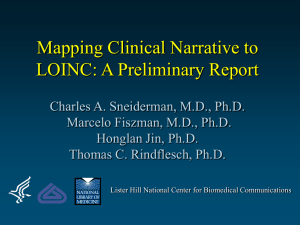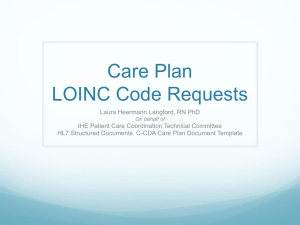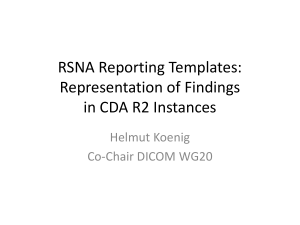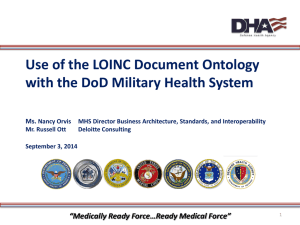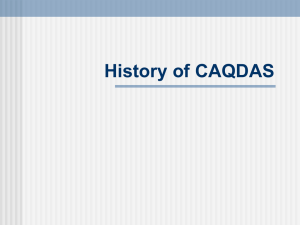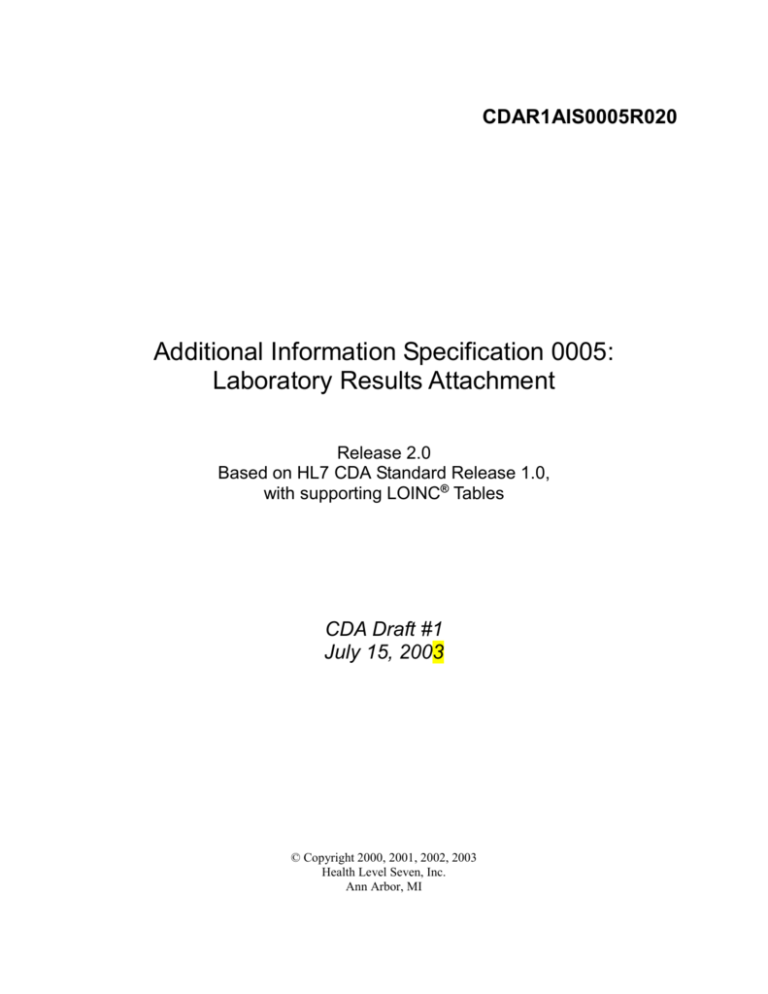
CDAR1AIS0005R020
Additional Information Specification 0005:
Laboratory Results Attachment
Release 2.0
Based on HL7 CDA Standard Release 1.0,
with supporting LOINC® Tables
CDA Draft #1
July 15, 2003
© Copyright 2000, 2001, 2002, 2003
Health Level Seven, Inc.
Ann Arbor, MI
Table of Contents
1
INTRODUCTION ...............................................................................................................................................1
1.1
1.2
1.3
1.4
1.5
1.6
1.7
2
USE OF THE CDA FOR LABORATORY RESULTS ....................................................................................4
2.1
2.2
3
LOINC CODES AND STRUCTURE ....................................................................................................................2
REVISION HISTORY .........................................................................................................................................2
PRIVACY CONCERNS IN EXAMPLES ................................................................................................................2
HL7 ATTACHMENT-CDA DOCUMENT VARIANTS ..........................................................................................3
REQUEST FOR INFORMATION VERSUS REQUEST FOR SERVICE ........................................................................3
SPECIFYING LABORATORY OBSERVATIONS ....................................................................................................3
REQUIREMENTS FOR SENDING LABORATORY RESULTS ..................................................................................3
HUMAN-DECISION VARIANT, XML BODY .....................................................................................................4
ADDITIONAL REQUIREMENTS FOR THE COMPUTER-DECISION VARIANT ........................................................5
LOINC CODES ...................................................................................................................................................6
3.1
LABORATORY RESULTS SUPPORTING DOCUMENTATION ................................................................................6
3.1.2
Requests for individual results ...............................................................................................................8
3.1.3
Requests for classes of laboratory test results. .......................................................................................8
3.1.4
Requests for all laboratory tests set ..................................................................................................... 10
3.2
SCOPE MODIFICATION CODES ...................................................................................................................... 10
3.3
CODING EXAMPLE ........................................................................................................................................ 11
3.1.1
Human-Decision Variant ..................................................................................................................... 12
3.1.2
Computer-Decision Variant ................................................................................................................. 16
4
VALUE TABLES FOR SPECIFIC REPORT STRUCTURES .................................................................... 20
5
RESPONSE CODE SETS ................................................................................................................................. 20
5.1
5.2
5.3
5.4
ISO+: EXTENDED ISO UNITS CODES ............................................................................................................. 20
HL70078: ABNORMAL FLAGS ...................................................................................................................... 29
HL70085: HL7 OBSERVATION RESULTS STATUS. ......................................................................................... 30
NPI: NATIONAL PROVIDER ID ...................................................................................................................... 30
Index of Tables
Table 1.1 Relationship of LOINC Codes, X12N Transactions, and HL7 ORU Message .............................................2
Table 3.1 – LOINC Report Subject Identifier Codes.....................................................................................................7
Table 3.3.1- First Battery ............................................................................................................................................. 11
Table 3.3.2 - Second Battery ....................................................................................................................................... 11
Table 5.5.1 - Status for an observation. ....................................................................................................................... 30
Table 3.1 is copyright, 1995-2003 Regenstrief Institute and the LOINC Attachment Committee. All
rights reserved.
Additional Information Specification 0005:
Laboratory Results Attachment
Release 2.0
Based on HL7 CDA Standard Release 1.0,
with supporting LOINC® Tables
1 Introduction
This publication provides the LOINC1 code values specific to the laboratory results attachment
for the following applications.
Certain codes will be used in transactions defined by the ASC X12N 277 Implementation
Guide (004020X104) Health Care Claim Request for Additional Information and the ASC
X12N 275 Implementation Guide (004020X107) Additional Information to Support a
Health Care Claim or Encounter which are products of the insurance subcommittee, X12N,
of Accredited Standards Committee X12.2,3
All of the codes may be used in HL7 Clinical Document Architecture (CDA) documents
designed for inclusion in the BIN segment of the 275 transaction as described in Health
Level Seven (HL7) Implementation Guide: Additional Information Message
Implementation Guide4
The format of this document (Is this true?} and the methods used to arrive at its contents are
prescribed in the HL7 Implementation Guide. Section 2 of this docuent defines the HL7 CDA
variants used for laboratory results attachment data. Section 3 defines the LOINC codes used to
request laboratory results attachment data and includes full examples of lab results in the humandecision and computer-decision variants.. Section 4 includes the value tables of LOINC codes
specific to the data elements of a laboratory results attachment.
LOINC codes are copyright 1995-2003 Regenstrief Institute and the LOINC® Committee. All rights
reserved.
1
LOINC® is a registered trademark of Regenstrief Institute and the LOINC Committee. The LOINC database is
copyright 1998-2001 Regenstrief Institute and the LOINC Committee and the LOINC database codes and namesis
available at no-cost from http://www.regenstrief.org/loinc/loinc.htm. Regenstrief Institute, 1050 Wishard Blvd.,
Indianapolis, IN 46202
Email: LOINC@regenstrief.iupui.edu
2
Information on this and other X12N/HIPAA-related implementation guides is available from the Washington
Publishing Company, Gaithersburg, MD. http://www.wpc-edi.com
3
Within this Health Level Seven document, references to the transaction defined by these X12N implementation
guides will be abbreviated by calling them 275 and 277.
4
Health Level Seven, Inc. 3300 Washtenaw Ave., Suite 227, Ann Arbor, MI 48104-4250. (http://www.hl7.org)
Laboratory Results Attachment
1
CDAR1AIS0005R020
Health Level Seven, Inc. 1998-2003. All rights reserved.
CDA Draft
July 15, 2003
1.1
LOINC Codes and Structure
LOINC codes are used for several different purposes in the two X12 transactions and HL7
message that are used to request and provide laboratory results. The table below identifies four
specific uses of LOINC codes and describes their use within the messages.
Table 1.1 Relationship of LOINC Codes, X12N Transactions, and HL7 ORU Message
X12N 277
X12N 275
HL7 ORU
Purpose of
Message
Request for additional
information to support a
health care claim
Additional information
to support a health care
claim or encounter
Provide structured
content for X12N 275
BIN segment
LOINC
Modifier
Codes
Used in the STC
segment to limit the time
frame or scope of the
request
Reiterated in the STC
segment
Not used
LOINC
Attachment
or Element
Codes
Used in the STC
segment to identify the
attachment or portion
thereof being requested
Reiterated in the STC
segment
Used to define the
attachment element
being addressed
Not used
Used to define the value
component of the
attachment element
LOINC
Answer Part
Codes
1.2
Not used
Revision History
Date
Sept 30, 1998
Oct 27, 1998
Nov 11, 1998
Aug 7, 2000
Oct 2000
May 2001
Dec 2001
Dec 2001
May 2002
Sept 2002
July 2003
1.3
Purpose
Initial release as separate document.
Revision based on comments.
Revise title, citations, and format of tables.
Update contact information.
Clarification and technical revisions.
Version update, title change, concept clarification, and continuity edits
Revised title and date; reconciled HL7 ballot
responses
Revised title and date; reconciled HL7 ballot responses
Editing changes requested by the balloters
Revised LOINC e-mail address, LOINC report subject identifier codes and
HL7 message examples
Revision for CDA
Privacy Concerns in Examples
The names of natural persons that appear in the examples of this book are intentionally fictional.
Any resemblance to actual natural persons, living or deceased, is purely coincidental.
Laboratory Results Attachment
2
CDAR1AIS0005R020
Health Level Seven, Inc. 1998-2003. All rights reserved.
CDA Draft
July 15, 2003
1.4
HL7 Attachment-CDA Document Variants
As described in the HL7 Implementation Guide, there are two variants of a CDA document when
used as an attachment under HIPAA.
1.5
The human-decision variant is used solely for information that will be rendered for a person
to look at, in order to make a decision. HL7 provides a non-normative style sheet for this
purpose.
The computer-decision variant has the same content as the human-decision variant, but
additional coded and structured information is included so that a computer could provide
decision support based on the document. Attachments in the computer-decision variant can
be rendered for human decisions using the same style sheet that HL7 provides for rendering
documents formatted according to the human-decision variant.
Request for Information versus Request for Service
This attachment is a “send-what-you-have” attachment. It is asking for laboratory results that have been
produced in the course of the care process. It is not asking for any additional data capture efforts. For
example, if the request for data is all Hematology test results, it is not asking the provider to run any specific
hematology test procedure, rather it is asking for the provider to send those that happen to have been during
the time frame of the request.
1.6
Specifying Laboratory Observations
When a payer sends a request for supporting documentation, the payor does not have to
enumerate every specific test result of interest. LOINC provides codes for large classes of
laboratory test results (e.g., chemistry tests) as well as codes for individual test results such as
serum potassium concentration. Either kind of code can be used as a subject identifier. As of July
2000, there were more than 22,400 LOINC codes identifying various kinds of lab observations.
Whereas most laboratory LOINC codes identify very specific test measurements. The categories
(sets) defined in the LOINC Report Subject have sufficient breadth to allow the payer to request a
useful subset of laboratory tests with a single code.
The provider will respond to these LOINC class code with the set of individual test results
contained within these codes that have been performed on the patient.
1.7
Requirements for Sending Laboratory Results
Laboratory results are transmitted using the HL7 CDA document. There are a variety of
implementation models for the ORU message in sending lab results. In order to describe a
workable set of requirements for the receiving systems, the ORU message variant for lab results
in claims attachments imposes a specific set of implementation requirements that limit the
information and format variations that may be sent as a claims attachment.
The requirements are:
The patient must be identified.
Observations must be fully contained in the transmitted CDA document, without reference
to previous or subsequent messages.
Antimicrobial susceptibility studies are not covered at this time.
Laboratory Results Attachment
3
CDAR1AIS0005R020
Health Level Seven, Inc. 1998-2003. All rights reserved.
CDA Draft
July 15, 2003
2 Use of the CDA for Laboratory Results
2.1
Human-Decision Variant, XML Body
When the provider sends a result using the CDA in the human-decision variant with an XML
body, all laboratory results shall be presented in the following way:
Each battery or other logical grouping shall be sent as a <section> element.
Each such section shall contain a <caption> element identifying the battery.
The <caption> element shall include the producer's name for the battery. For example, if an
attachment is being prepared in response to a request for LOINC code 18720-3
(coagulation tests), and the local lab calls the battery that was ordered "pre operative
coagulation studies," then the <caption> element should include the text "pre operative
coagulation studies."
Where the lab attachment is prepared in response to a 277 message from the payer, the
<caption> elements for a section should contain a <caption_cd> element that echoes the
LOINC code received in the 277.
Each such section shall contain a <table> element. Each rows of this table except the
header shall contain the individual observation.
The columns of the table shall be labeled: Result Name, Result Value, Units, Normal
Range, Abnormal Flag and Date/Time.
A table cell in the Result Name column shall have text that identifies the observation in that
row. The table cell may contain a <caption_cd> element with the LOINC code that
identifies the observation.
A table cell in the Result Value column shall have the result, which may be a numeric
value, a code, a string, or text. If the result is a code, the cell should also include the textual
interpretation of the code.
When an observation has a numeric value (rather than a coded or textual value) then an
appropriate units of measure should be reported in the Units column. Where units are not
appropriate (for example, for a numerical ratio such as specific gravity) no value shall be
used in this column.
Where the laboratory reported a normal range for an observation the normal range shall be
included in the Normal Range column.
Where the laboratory determined that the reported value is abnormal the Abnormal Flag
column shall contain a code drawn from table HL70078.
The Date/Time columns shall include a text value that conveys the clinically relevant date
and time for the observation.
The data in the Result Value column must represent the information described by the CDA
caption for the result. If a specimen was taken, but results cannot be obtained, it is
acceptable to send X in the Status column and the reason that results cannot be obtained in
a comment in the following row.
Comments that apply to an individual row in the table may appear in a separate <tr>
element following the <tr> element that defines a row of observations. Such comments may
describe or explain a result but must not alter the meaning of the result.
Laboratory Results Attachment
4
CDAR1AIS0005R020
Health Level Seven, Inc. 1998-2003. All rights reserved.
CDA Draft
July 15, 2003
Comments that apply to an entire section may appear as CDA content (paragraphs, list, or
tables) before or after the <table> element that conveys the results for the section. Such
comments may describe or explain a result but must not alter the meaning of the result.
Note to reviewers: Perhaps the most unusual part of this proposal is not
providing the equivalent to OBX-11, the observation status. Instead we
propose to let them use a comment field to convey the information if the
result specimen was obtained but no result was possible.
2.2
Additional Requirements for the Computer-Decision Variant
Except as described in this sections, the requirements for Human-Decision Variant shall also be
followed for lab results reported using CDA documents in the computer-decision variant. The
following requirements supplement or modify the above requirements.
Each <caption> element shall contain a <caption_cd> element that includes the LOINC
code for the caption of the section or individual observation. Example
<tr>
<th>urine color<caption_cd V="5778-6"/></th>
<td>STRAW</td><td/><td/><td/>
<td>
<local_markup descriptor="dt_ts">
1995-10-21T18:38</local_markup>
</td>
</tr>
The entry in the Result Value column shall be encoded according to the specifications for
the computer-decision variant in the Additional Information Message Implementation
Guide. For numeric, string, or text data this is not different than the representation that
would be used for the human-decision variant.
Entries in the Units column shall be coded as described for the CE data type in the
Additional Information Message Implementation Guide. For example
<tr>
<th>urine urobilinogen<caption_cd V="20405-7"/>
</th>
<td>0.2</td>
<td><coded_entry><coded_entry.value V="mg/dL" S="need.OID"/>
</coded_entry>
</td>
<td>0.2-1.0</td>
<td/>
<td>
<local_markup descriptor="dt_ts">1995-10-21T18:38</local_markup>
</td>
</tr>
Non-empty entries in the Abnormal Flag column must appear as the CE data type. For
example:
<tr>
<th>monocytes count<caption_cd V="742-7"/></th>
Laboratory Results Attachment
5
CDAR1AIS0005R020
Health Level Seven, Inc. 1998-2003. All rights reserved.
CDA Draft
July 15, 2003
<td>1.6</td>
<td><coded_entry>
<coded_entry.value V="10*3/mm3" S="need.OID"/>
</coded_entry>
</td>
<td>0.0-0.9</td>
<td><coded_entry><coded_entry.value V="H" S="need.OID"/>
</coded_entry>
</td>
<td>
<local_markup descriptor="dt_ts">1995-10-21T18:38</local_markup>
</td>
</tr>
Entries in the Date/Time column shall be encoded as described for the TS data type in the
HL7 Additional Information Specification Implementation Guide For example
<tr>
<th>monocytes count<caption_cd V="742-7"/></th>
<td>1.6</td>
<td><coded_entry>
<coded_entry.value V="10*3/mm3" S="need.OID"/>
</coded_entry>
</td>
<td>0.0-0.9</td>
<td><coded_entry><coded_entry.value V="H" S="need.OID"/>
</coded_entry>
</td>
<td>
<local_markup descriptor="dt_ts">1995-10-21T18:38</local_markup>
</td>
</tr>
3 LOINC Codes
3.1
Laboratory Results Supporting Documentation
Table 3.1 defines the LOINC code used to request a complete attachment data set specific to
laboratory results. The use of this code in the 277 STC segment represents an explicit request for
the complete set of data elements relevant to the laboratory results.
The provider shall return all data elements for which data is available. The minimum attachment
data set equates to the required elements; those identified in the value table at Section 4 with a
cardinality (Card) of {1,1} (element is required and has one and only one occurrence) or {1,n}
(element is required and has one or more occurrences). Those data elements with a cardinality of
{0,1} (if available has one and only one occurrence) or {0,n} (if available may have one or more
occurrences) shall be sent if available.
Table 3.1 lists the LOINC codes that represent the current major classes of laboratory results.
The LOINC database includes a tree structure that links the LOINC term, “all laboratory studies”
Laboratory Results Attachment
6
CDAR1AIS0005R020
Health Level Seven, Inc. 1998-2003. All rights reserved.
CDA Draft
July 15, 2003
(LOINC 26436-6), to each of its major classes (see Table 3.1) and further links each of these
classes to the LOINC codes for the individual laboratory test observations they contain. Any of
the LOINC codes in this hierarchy are valid LOINC report subject codes for the 277-request for
supporting documentation message. When a requestor asks for 26436-6 (all laboratory studies
(set)), the organization answering that request will return all laboratory results related to a given
claim that also satisfy the constraints imposed by the modifier codes submitted in the 277. When
a requestor asks for a class of laboratory tests e.g., coagulation tests (set) (LOINC 18720-3) or
chemistry tests (set) (LOINC 18719-5), the organization answering that request would return all
coagulation tests or all chemistry tests respectively. When a requestor asks for a single LOINC
code (e.g., 2974-1 blood sodium concentrate) the organization returns the test results for that
sodium value only.
Table 3.1 – LOINC Report Subject Identifier Codes
LOINC
Code
Report Subject (or Response Specified)
26436-6 ALL LABORATORY STUDIES (SET)
18716-1
ALLERGY TESTS (SET)
18717-9
BLOOD BANK TESTS (SET)
18767-4
BLOOD GAS TESTS (SET)
18718-7
CELL MARKER TESTS (SET)
18719-5
CHEMISTRY TESTS (SET)
26437-4
CHEMISTRY CHALLENGE STUDIES
18720-3
COAGULATION TESTS (SET)
26438-2
CYTOLOGY STUDIES (SET)
18722-9
FERTILITY TESTS (SET)
18723-7
HEMATOLOGY TESTS + CELL COUNTS (SET)
18724-5
HLA TESTS (SET)
18725-2
MICROBIOLOGY TESTS (SET)
26435-8
MOLECULAR PATHOLOGY STUDIES (SET)
18727-8
SEROLOGY TESTS (SET)
26439-0
PATHOLOGY REPORTS SECTIONS + STAINS (SET)
18721-1
TOXICOLOGY + THERAPEUTIC DRUG MONITORING
TESTS (SET)
18729-4
URINALYSIS STUDIES (SET)
Note: The above table does not include antibiotic susceptibilities because they
are not covered in this guide.
Table 3.1 Copyright 1998-2001 Regenstrief Institute and the LOINC® Attachment Committee.
All rights reserved
Table 3.1 – LOINC Report Subject Identifier Codes shows the two top levels of the laboratory
test hierarchy within LOINC. LOINC 26436-6 (all Laboratory Studies) is at the first level and
classes (such as 18719-5 chemistry tests and 18720-3 coagulation tests) are at the second level in
the hierarchy. The LOINC codes for the individual tests within a given class are listed in the
LOINC database, but because there are more than 20,000 such LOINC codes they are not listed in
this booklet. Users can view the list of LOINC observation contained within any level of the
hierarchy through the “HIPAA attachment” task in ™, a PC LOINC browsing program, available
Laboratory Results Attachment
7
CDAR1AIS0005R020
Health Level Seven, Inc. 1998-2003. All rights reserved.
CDA Draft
July 15, 2003
at no cost from the Regenstrief Institute. RELMA™ 6, a PC LOINC browsing program, available
at no cost from the Regenstrief Institute. (www.regenstrief.org/loinc/ - send questions by email to
LOINC@regenstrief.org.)
The Regenstrief Institute and LOINC committee will add more refined classes within the existing
major classes as requested by the industry to provide for more precisely targeted laboratory test
subsets (for example, thyroid tests). Furthermore, to serve the needs of laboratory reporting, the
Regenstrief Institute and the LOINC committee will also continue to add new laboratory LOINC
codes as laboratory technology expands and new tests for biomarkers and biochemicals and other
laboratory measurements are introduced. These new laboratory codes would be contained within
the laboratory hierarchy (LOINC 26436-6) and would also be valid subject identifiers for report
identifiers in 277-request messages.
In standard HL7 report messages, these test results are often delivered grouped as batteries of
individual observations ordered as a package. This standard reporting structure is also reflected
in the HL7 message returned in the 275 to the requestor. The goal is to keep the messages sent in
attachments as close as possible to be equivalent messages used in daily care operations.
3.1.1 Contents of Laboratory test classes
The content of the laboratory test classes given in Table 3.1 should be obvious from the name.
However some of these need more specification.
Microbiology includes all tests used to identify microorganisms and evidence for infection by
specific organisms as well as cultures direct microscopic exams that identify organisms or prove
evidence for present or past infection with specific organisms. Microbiology includes tests for
antibodies, antigens, DNA and RNA. The serology class does not include measures of antibodies
or antigens related to microorganisms. And molecular pathology class does not include RNA or
DNA based tests for infectious organisms. (They are all included in microbiology.)
The class blood bank includes all blood bank testing including ABO-Rh testing. Allergies
include testing to allergens (cat dander, trees, etc). Serology includes rheumatology
autoantibodies, and antigen measures not covered by these two classes.
Hematology, as defined, excludes cell counts and differential counts which will be found in cell,
differential counts, and coagulation studies, respectively. Measures of complement activity are
included within hematology, not chemistry.
Chemistry does not include challenge tests such as Glucose tolerance, ACTH stimulation, etc.
These have their own category, chemistry challenge tests.
3.1.2 Requests for individual results
When the LOINC report codes requested in the 277 is an atomic test result
(like blood sodium, or prothrombin time-patient) then only a single
observation row will be returned in the result table in the 275.
3.1.3 Requests for classes of laboratory test results.
When the 277 request for supporting information asks for a LOINC codes that is a class of
laboratory observations, the CDA document returned will include a one or more sections, each of
6
RELMA is a trademark of Regenstrief Institute
Laboratory Results Attachment
8
CDAR1AIS0005R020
Health Level Seven, Inc. 1998-2003. All rights reserved.
CDA Draft
July 15, 2003
which has a table that contains one or more result rows using the same general structure that
would have been delivered to the hospital or clinic that ordered those tests in the first place. In
this case, the caption for the section will identify the LOINC parent class to which the first result
in that battery belongs. More specifically this will be the parent LOINC class per the RELMA™
7
attachment hierarchy of the first row. So, if the requested LOINC code in the 275 message was
18720-3 (coagulation tests), then 18720-3 coagulation tests would be reported in the caption of
the section of each coagulation test battery returned because 18720-3 is the immediate parent of
the first coagulation tests. The producer’s name for each individual battery must be placed in the
caption. For example, if an attachment is being prepared in response to a request for LOINC code
18720-3 (coagulation tests), and the local lab calls the battery that was ordered "pre operative
coagulation studies," then the <caption> element should include the text "pre operative
coagulation studies."
When the 277 request is for a class of tests, then the returned 275 will often contain multiple
sections each with its own table of results. For example, if the 277 request was for all coagulation
tests (LOINC 18720-3), the table might include rows for the prothrombin time patient (LOINC
6301-6) as well as other coagulation studies such as APPT (LOINC 16631-4).
If chemistry tests (LOINC 18719-5) was requested in the 277 message, then
the CDA response might include blood sodium, but in this case, the sodium
result would be returned in the section for a battery that also contained
other chemistry tests and the response might also include other chemistry
test batteries. Because #18719-5 (chemistry tests) is the immediate
parent for all chemistry tests, the sodium result would be a row in a
table that is within a section that has a caption containing #18719-5
(chemistry tests). If the producer’s name for this battery was
“electrolytes panel,” it would contain “electrolytes panel” in the PCDATA
for the <caption> element.
Within this table we would likely see at least four rows, one for sodium, potassium, chloride and
bicarbonate results respectively, because those chemistry tests are often done together in batteries
called “electrolytes” as shown in the following example shown in the human-decision variant.
7
RELMA is a trademark of Regenstrief Institute
Laboratory Results Attachment
9
CDAR1AIS0005R020
Health Level Seven, Inc. 1998-2003. All rights reserved.
CDA Draft
July 15, 2003
<tbody>
<tr>
<th>SODIUM</th>
<td>142</td>
<td>mmol/L</td>
<td>135-145</td>
<td/><td>1 Nov 2000 2:25 PM</td>
</tr>
<tr>
<th>POTASSIUM</th>
<td>4.0</td>
<td>mmol/L</td>
<td>3.5-4.5</td>
<td/><td>1 Nov 2000 2:25 PM</td>
</tr>
<tr>
<th>CHLORIDE</th>
<td>100</td>
<td>mmol/L</td>
<td>95-105</td>
<td/><td>1 Nov 2000 2:25 PM</td>
</tr>
<tr>
<th>BICARBONATE</th>
<td>26</td>
<td>mmol/L</td>
<td>22-26</td>
<td/><td>1 Nov 2000 2:25 PM</td>
</tr>
</tbody>
3.1.4 Requests for all laboratory tests set
When the report subject code in the 277 is LOINC 26436-6 “all laboratory tests” the LOINC code
or descriptive phrase returned in the caption for each section will still be the one that is the
immediate parent of the LOINC code for the test reported in the first data row of the table, e.g.,
the code for chemistry tests, hematology tests, or one of the other class codes in Table 3.1 It will
not be all laboratory tests because that is not the immediate parent for any specific result. As is
true for coagulation tests, we might see more than one battery containing 18719-5 in the section
caption, assuming the patient had more than one chemistry battery performed that satisfied the
query scope modifiers. Section 3.3 gives a complete example for a patient who had two batteries
performed at one encounter.
3.2 Scope Modification Codes
The LOINC publication LOINC Modifier Codes as used in the ASC X12N 277 Implementation
Guide (004020X104) Health Care Claim Request for Additional Information provides code
values for further defining the specificity of a request for additional information. Both time
window and item selection modifier codes are defined.
Laboratory Results Attachment
10
CDAR1AIS0005R020
Health Level Seven, Inc. 1998-2003. All rights reserved.
CDA Draft
July 15, 2003
3.3 Coding Example
Scenario: A payer was reviewing a claim for a male patient named Patient H. Sample who was
born on 24 September 1932 for an encounter with George F. Carson, MD that occurred on
October 2, 1995. The payer sends a 277 requesting information for LOINC codes 26436-6 (all
laboratory tests). The request message included modifier codes that restrict the request to the last
result for any laboratory test obtained during the relevant encounter.
Assume that patient has had only two test batteries performed during the encounter, a urinalysis
and an automated blood count. Assume also that a response message was created on October 22,
1995 at 6:38:00 PM and that the patient's medical record ID at the sending institution is 6910828
and the billing account number for this encounter is 773789090.
The response includes results from the complete urinalysis and an automated blood count that
was ordered for the patient. The two batteries are each in separate sections, and each such section
contains a table with a row for each individual measurements that are part of their respective
battery.
In the first section the caption includes the producer's name for the battery, "Urinalysis complete."
In the computer-decision variant the producer's name is supplemented with the LOINC code
18729-4 (urinalysis tests) in the <caption_cd> element. The table rows convey the information
shown in the following table.
Table 3.3.1- First Battery
LOINC
Code
Result name
Result
value
Units
Normal
Range
Abnormal
flag
A
5778-6
urine color
STRAW
5767-9
urine appearance
CLEAR
5792-7
urine glucose (test strip)
1+
NEG
5770-3
urine bilirubin (test strip)
NEG
NEG
5797-6
urine ketones (test strip)
NEG
NEG
5811-5
urine specific gravity (test strip)
1.007
1.0051.030
5803-2
urine pH (test strip)
6
5.0-8.0
204057
urine urobilinogen
0.2
mg/dL
0.2-1.0
1
/(hpf)
0-3
13945-1 urine erythrocytes
Clinically
relevant
date/time
10/2/1995
6:38 PM
10/2/1995
6:38 PM
10/2/1995
6:38 PM
10/2/1995
6:38 PM
10/2/1995
6:38 PM
10/2/1995
6:38 PM
10/2/1995
6:38 PM
10/2/1995
6:38 PM
10/2/1995
6:38 PM
In the second section the caption is "Hematology Tests + Cell Counts" and, in the computerdecision variant the <caption_cd> element contains the LOINC code 18723-7 (Hematology Tests
+ Cell Counts).
Table 3.3.2 - Second Battery
Laboratory Results Attachment
11
CDAR1AIS0005R020
Health Level Seven, Inc. 1998-2003. All rights reserved.
CDA Draft
July 15, 2003
LOINC
Code
4544-3
Result name
hematocrit
789-8
erythrocytes count
787-2
mean corpuscular volume
777-3
platelets count
6690-2
leukocytes count
Result
value
Units
45
4.94
Normal
Range
Abnormal
flag
39-49
10*6/mm3
4.30-5.90
91
fl
90-98
233
10*3/mm3
150-450
25
10*3/mm3
3.2-9.8
H
H
770-8
neutrophils/100 leukocytes
83.1
%
37.0-80.0
706-2
basophils/100 leukocytes
10.1
%
10.0-50.0
5905-5
monocytes/100 leukocytes
6.3
%
0.0-12.0
713-8
eosinophils/100 leukocytes
0.3
%
0.0-7.0
706-2
basophils/100 leukocytes
0.2
%
0.0-2.0
751-8
neutrophils count
20.8
10*3/mm3
2.0-7.0
731-0
lymphocytes count
2.5
10*3/mm3
0.6-3.5
742-7
monocytes count
1.6
10*3/mm3
0.0-0.9
711-2
eosinophils count
0.08
10*3/mm3
0.00-0.70
704-7
basophils count
0.04
10*3/mm3
0.00-0.20
H
H
Clinically
relevant
date/time
10/2/1995
6:38 PM
10/2/1995
6:38 PM
10/2/1995
6:38 PM
10/2/1995
6:38 PM
10/2/1995
6:38 PM
10/2/1995
6:38 PM
10/2/1995
6:38 PM
10/2/1995
6:38 PM
10/2/1995
6:38 PM
10/2/1995
6:38 PM
10/2/1995
6:38 PM
10/2/1995
6:38 PM
10/2/1995
6:38 PM
10/2/1995
6:38 PM
10/2/1995
6:38 PM
The CDA document that will be included within the 275 response message is shown below.
3.1.1 Human-Decision Variant
Document
Header
Document type
code identifies all
lab studies.
Patient encounter
identified with
provider account
number.
George Carson,
MD, identified as
the provider MD.
<levelone xmlns="urn:hl7-org:v3/cda" xmlns:v3dt="urn:hl7-org:v3/v3dt"
xmlns:xsi="http://www.w3.org/2001/XMLSchema-instance" xsi:schemaLocation="urn:hl7org:v3/cda
C:\DOCUME~1\wrishel\MYDOCU~1\HL7\CDA\R1Schemas\FromVassil\levelone_1.0.wes.xsd
">
<clinical_document_header>
<id EX="a123" RT="2.16.840.1.113883.3.933"/>
<document_type_cd V="26436-6" DN="All Laboratory Studies"/>
<origination_dttm V="1995-10-25"/>
<patient_encounter>
<id EX="773789090" RT="2.16.840.1.113883.3.933"/>
<encounter_tmr V="1995-10-02"/>
</patient_encounter>
<provider>
<provider.type_cd V="PRF"/>
<person>
<id EX="298379" RT="2.16.840.1.113883.3.933"/>
<person_name>
Laboratory Results Attachment
12
CDAR1AIS0005R020
Health Level Seven, Inc. 1998-2003. All rights reserved.
CDA Draft
July 15, 2003
Patient
Identification
Includes name,
date of birth and
gender.
Begin Body, first
Section and table
heading.
urine color
urine appearance,
with comment
<nm>
<v3dt:GIV V="George"/>
<v3dt:MID V="F"/>
<v3dt:FAM V="Carson"/>
<v3dt:SFX V="MD" QUAL="PT"/>
</nm>
<person_name.type_cd V="L" S="2.16.840.1.113883.5.200"/>
</person_name>
</person>
</provider>
<patient>
<patient.type_cd V="PATSBJ"/>
<person>
<id EX="6910828" RT="need OID"/>
<!-- provider's patient med rec # -->
<person_name>
<nm>
<v3dt:GIV V="Sample"/>
<v3dt:FAM V="Patient"/>
<v3dt:MID V="H"/>
</nm>
<person_name.type_cd V="L"
S="2.16.840.1.113883.5.200"/>
</person_name>
</person>
<birth_dttm V="1932-09-24"/>
<administrative_gender_cd V="M" S="2.16.840.1.113883.5.1"/>
</patient>
</clinical_document_header>
<body>
<section>
<caption>URINALYSIS COMPLETE</caption>
<table>
<thead>
<tr>
<th>Result name</th>
<th>Result value</th>
<th>Units</th>
<th>Normal Range</th>
<th>Abnormal flag</th>
<th>date/time</th>
</tr>
</thead>
<tbody>
<tr>
<th>urine color</th>
<td>STRAW</td>
<td/>
<td/>
<td/>
<td>10/2/1995 6:38 PM</td>
</tr>
<tr>
<th>urine appearance</th><td>CLEAR</td>
<td/><td/><td/><td>10/2/1995 6:38 PM</td>
</tr>
<tr>
<th/>
Laboratory Results Attachment
13
CDAR1AIS0005R020
Health Level Seven, Inc. 1998-2003. All rights reserved.
CDA Draft
July 15, 2003
<td>This is a comment that applies to the urine appearance
observation.</td>
urine glucose,
urine bilirubin,
urine ketones,
urine pH, urine
urobilinogen,
urine
erythrocytes
Comment that
applies to entire
battery.
Second Battery
</tr>
<tr><th>urine glucose (test strip)</th>
<td>1+</td><td/><td>NEG</td><td>A</td>
<td>10/2/1995 6:38 PM</td>
</tr>
<tr><th>urine bilirubin (test strip)</th><td>NEG</td>
<td/><td>NEG</td><td/><td>10/2/1995 6:38 PM</td>
</tr>
<tr><th>urine ketones (test strip)</th><td>NEG</td>
<td/><td>NEG</td><td/><td>10/2/1995 6:38 PM</td>
</tr>
<tr><th>urine specific gravity (test strip)</th>
<td>1.007</td><td/><td>1.005-1.030</td>
<td/><td>10/2/1995 6:38 PM</td>
</tr>
<tr><th>urine pH (test strip)</th><td>6</td>
<td/><td>5.0-8.0</td><td/>
<td>10/2/1995 6:38 PM</td>
</tr>
<tr><th>urine urobilinogen</th><td>0.2</td>
<td>mg/dL</td><td>0.2-1.0</td>
<td/><td>10/2/1995 6:38 PM</td>
</tr>
<tr><th>urine erythrocytes</th><td>1</td>
<td>/(hpf)</td><td>0-3</td><td/>
<td>10/2/1995 6:38 PM</td>
</tr>
</tbody>
</table>
<paragraph>
<caption>Comment</caption>
<content>This is a comment that applies to the entire urinalysis complete
battery.</content>
</paragraph>
</section>
<section>
<caption>AUTO BLOOD CT WITH AUTO DIFF</caption>
<table>
<thead>
<tr><th>Result name</th>
<th>Result value</th>
<th>Units</th>
<th>Normal Range</th>
<th>Abnormal flag</th>
<th>date/time</th>
</tr>
</thead>
<tbody>
<tr><th>hematocrit</th><td>45</td><td/>
<td>39-49</td><td/>
<td>10/2/1995 6:38 PM</td>
</tr>
<tr><th>erythrocytes count</th>
<td>4.94</td><td>10*6/mm3</td>
<td>4.30-5.90</td><td/>
<td>10/2/1995 6:38 PM</td>
Laboratory Results Attachment
14
CDAR1AIS0005R020
Health Level Seven, Inc. 1998-2003. All rights reserved.
CDA Draft
July 15, 2003
</tr>
<tr><th>mean corpuscular volume</th><td>91</td>
<td>fl</td><td>90-98</td><td/>
<td>10/2/1995 6:38 PM</td>
</tr>
<tr><th>platelets count</th>
<td>233</td><td>10*3/mm3</td>
<td>150-450</td><td/><td>10/2/1995 6:38 PM</td>
</tr>
<tr><th>leukocytes count</th>
<td>25</td><td>10*3/mm3</td><td>3.2-9.8</td>
<td>H</td><td>10/2/1995 6:38 PM</td>
</tr>
<tr><th>neutrophils/100 leukocytes</th>
<td>83.1</td><td>%</td><td>37.0-80.0</td>
<td>H</td><td>10/2/1995 6:38 PM</td>
</tr>
<tr><th>basophils/100 leukocytes</th>
<td>10.1</td><td>%</td><td>10.0-50.0</td><td/>
<td>10/2/1995 6:38 PM</td>
</tr>
<tr><th>monocytes/100 leukocytes</th>
<td>6.3</td><td>%</td><td>0.0-12.0
</td><td/><td>10/2/1995 6:38 PM</td>
</tr>
<tr><th>eosinophils/100 leukocytes</th>
<td>0.3</td><td>%</td><td>0.0-7.0</td><td/>
<td>10/2/1995 6:38 PM</td>
</tr>
<tr><th>basophils/100 leukocytes</th>
<td>0.2</td><td>%</td><td>0.0-2.0</td><td/>
<td>10/2/1995 6:38 PM</td>
</tr>
<tr><th>neutrophils count</th>
<td>20.8</td><td>10*3/mm3</td>
<td>2.0-7.0</td><td>H</td>
<td>10/2/1995 6:38 PM</td>
</tr>
<tr><th>lymphocytes count</th>
<td>2.5</td><td>10*3/mm3</td>
<td>0.6-3.5</td><td/>
<td>10/2/1995 6:38 PM</td>
</tr>
<tr><th>monocytes count</th>
<td>1.6</td><td>10*3/mm3</td>
<td>0.0-0.9</td><td>H</td>
<td>10/2/1995 6:38 PM</td>
</tr>
<tr><th>eosinophils count</th>
<td>0.08</td><td>10*3/mm3</td>
<td>0.00-0.70</td><td/>
<td>10/2/1995 6:38 PM</td>
</tr>
<tr><th>basophils count</th>
Laboratory Results Attachment
15
CDAR1AIS0005R020
Health Level Seven, Inc. 1998-2003. All rights reserved.
CDA Draft
July 15, 2003
Close body and
document
<td>0.04</td><td>10*3/mm3</td>
<td>0.00-0.20</td><td/>
<td>10/2/1995 6:38 PM</td>
</tr>
</tbody>
</table>
</section>
</body>
</levelone>
3.1.2 Computer-Decision Variant
Significant differences when compared to the human-decision variant are shown in boldface.
<levelone xmlns="urn:hl7-org:v3/cda" xmlns:v3dt="urn:hl7-org:v3/v3dt"
xmlns:xsi="http://www.w3.org/2001/XMLSchema-instance" xsi:schemaLocation="urn:hl7org:v3/cda
C:\DOCUME~1\wrishel\MYDOCU~1\HL7\CDA\R1Schemas\FromVassil\levelone_1.0.wes.xsd"
Document type
>
code identifies all
<clinical_document_header>
lab studies.
<id EX="a123" RT="2.16.840.1.113883.3.933"/>
<document_type_cd V="26436-6" DN="All Laboratory Studies"/>
Patient encounter
<origination_dttm V="1995-10-25"/>
identified with
<patient_encounter>
provider account
<id EX="773789090" RT="2.16.840.1.113883.3.933"/>
number.
<encounter_tmr V="1995-10-02"/>
George Carson,
</patient_encounter>
MD, identified as
the provider MD.
<provider>
<provider.type_cd V="PRF"/>
<person>
<id EX="298379" RT="2.16.840.1.113883.3.933"/>
<person_name>
<nm>
<v3dt:GIV V="George"/>
<v3dt:MID V="F"/>
<v3dt:FAM V="Carson"/>
<v3dt:SFX V="MD" QUAL="PT"/>
</nm>
<person_name.type_cd V="L" S="2.16.840.1.113883.5.200"/>
</person_name>
</person>
</provider>
<patient>
Patient
<patient.type_cd V="PATSBJ"/>
Identification
<person>
<id EX="6910828" RT="need OID"/>
Includes name,
<!-- provider's patient med rec # -->
date of birth and
<id EX="773789090" RT="need OID"/>
gender.
<!-- provider's account # -->
<person_name>
<nm>
<v3dt:GIV V="Sample"/>
<v3dt:FAM V="Patient"/>
<v3dt:MID V="H"/>
</nm>
<person_name.type_cd V="L" S="2.16.840.1.113883.5.200"/>
</person_name>
</person>
Laboratory Results Attachment
16
CDA Draft
CDAR1AIS0005R020
July 15, 2003
Health Level Seven, Inc. 1998-2003. All rights reserved.
Document
Header
Begin Body, first
Section and table
heading.
urine color
urine appearance,
urine glucose,
urine bilirubin,
urine ketones,
urine pH, urine
urobilinogen,
urine
erythrocytes
<birth_dttm V="1932-09-24"/>
<administrative_gender_cd V="M" S="2.16.840.1.113883.5.1"/>
</patient>
</clinical_document_header>
<body>
<section>
<caption>URINALYSIS COMPLETE
<caption_cd V="18729-4"/>
</caption>
<table>
<thead>
<tr>
<th>Result name</th>
<th>Result value</th>
<th>Units</th>
<th>Normal Range</th>
<th>Abnormal flag</th>
<th>Date/Time</th>
</tr>
</thead>
<tbody>
<tr>
<th>urine color<caption_cd V="5778-6"/>
</th>
<td>STRAW</td>
<td/>
<td/>
<td/>
<td>
<local_markup descriptor="dt_ts">1995-1021T18:38</local_markup>
</td>
</tr>
<tr><th>urine appearance<caption_cd V="5767-9"/></th>
<td>CLEAR</td><td/><td/><td/>
<td><local_markup descriptor="dt_ts">
1995-10-21T18:38</local_markup></td></tr>
<tr><th>urine glucose (test strip)
<caption_cd V="5792-7"/></th>
<td>1+</td><td/><td>NEG</td>
<td><coded_entry><coded_entry.value V="A" S="need.OID"/>
</coded_entry>
</td>
<td><local_markup descriptor="dt_ts">
1995-10-21T18:38</local_markup></td></tr>
<tr><th>urine bilirubin (test strip)<caption_cd V="5770-3"/></th>
<td>NEG</td><td/><td>NEG</td><td/>
<td><local_markup descriptor="dt_ts">
1995-10-21T18:38</local_markup></td></tr>
<tr><th>urine ketones (test strip)<caption_cd V="5797-6"/></th>
<td>NEG</td><td/><td>NEG</td><td/>
<td><local_markup descriptor="dt_ts">
1995-10-21T18:38</local_markup></td></tr>
<tr><th>urine specific gravity (test strip)<caption_cd V="5811-5"/></th>
<td>1.007</td><td/><td>1.005-1.030</td><td/>
<td><local_markup descriptor="dt_ts">
1995-10-21T18:38</local_markup></td></tr>
<tr><th>urine pH (test strip) <caption_cd V="5803-2"/></th>
<td>6</td><td/><td>5.0-8.0</td><td/>
<td><local_markup descriptor="dt_ts">
Laboratory Results Attachment
17
CDAR1AIS0005R020
Health Level Seven, Inc. 1998-2003. All rights reserved.
CDA Draft
July 15, 2003
Second Battery
1995-10-21T18:38</local_markup></td></tr>
<tr><th>urine urobilinogen<caption_cd V="20405-7"/></th>
<td>0.2</td>
<td><coded_entry><coded_entry.value V="mg/dL" S="need.OID"/>
</coded_entry>
</td><td>0.2-1.0</td><td/>
<td><local_markup descriptor="dt_ts">
1995-10-21T18:38</local_markup></td></tr>
<tr><th>urine erythrocytes<caption_cd V="13945-1"/></th>
<td>1</td><td>
<coded_entry><coded_entry.value V="/(hpf)"
S="need.OID"/>
</coded_entry>
</td>
<td>0-3</td><td/><td><local_markup descriptor="dt_ts">
1995-10-21T18:38</local_markup></td></tr>
</tbody>
</table>
</section>
<section>
<caption>Hematology Tests + Cell Counts
<caption_cd V="18723-7 "/></caption>
<table>
<thead>
<tr><th>Result name</th>
<th>Result value</th>
<th>Units</th>
<th>Normal Range</th>
<th>Abnormal flag</th>
<th>date/time</th></tr>
</thead>
<tbody>
<tr><th>hematocrit<caption_cd V="4544-3"/></th>
<td>45</td><td/><td>39-49</td><td/>
<td><local_markup descriptor="dt_ts">
1995-10-21T18:38</local_markup></td></tr>
<tr><th>erythrocytes count<caption_cd V="789-8"/></th>
<td>4.94</td><td><coded_entry><coded_entry.value V="10*6/mm3"
S="need.OID"/>
</coded_entry>
</td><td>4.30-5.90</td><td/><td><local_markup descriptor="dt_ts">
1995-10-21T18:38</local_markup></td></tr>
<tr><th>mean corpuscular volume<caption_cd V="787-2"/></th>
<td>91</td>
<td><coded_entry><coded_entry.value V="fl" S="need.OID"/>
</coded_entry>
</td><td>90-98</td><td/>
<td><local_markup descriptor="dt_ts">
1995-10-21T18:38</local_markup></td></tr>
<tr><th>platelets count<caption_cd V="777-3"/></th>
<td>233</td>
<td><coded_entry><coded_entry.value V="10*3/mm3" S="need.OID"/>
</coded_entry>
</td><td>150-450</td><td/>
<td><local_markup descriptor="dt_ts">
1995-10-21T18:38</local_markup></td></tr>
<tr><th>leukocytes count<caption_cd V="6690-2"/></th>
<td>25</td>
<td><coded_entry><coded_entry.value V="10*3/mm3" S="need.OID"/>
</coded_entry>
Laboratory Results Attachment
18
CDAR1AIS0005R020
Health Level Seven, Inc. 1998-2003. All rights reserved.
CDA Draft
July 15, 2003
</td><td>3.2-9.8</td><td><coded_entry><coded_entry.value V="H"
S="need.OID"/>
</coded_entry>
</td>
<td><local_markup descriptor="dt_ts">
1995-10-21T18:38</local_markup></td></tr>
<tr><th>neutrophils/100 leukocytes<caption_cd V="770-8"/></th>
<td>83.1</td><td><coded_entry><coded_entry.value V="%"
S="need.OID"/>
</coded_entry>
</td>
<td>37.0-80.0</td>
<td><coded_entry><coded_entry.value V="H" S="need.OID"/>
</coded_entry>
</td>
<td><local_markup descriptor="dt_ts">
1995-10-21T18:38</local_markup></td></tr>
<tr><th>basophils/100 leukocytes<caption_cd V="706-2"/></th>
<td>10.1</td>
<td><coded_entry><coded_entry.value V="%" S="need.OID"/>
</coded_entry>
</td><td>10.0-50.0</td>
<td/>
<td><local_markup descriptor="dt_ts">
1995-10-21T18:38</local_markup></td></tr>
<tr><th>monocytes/100 leukocytes<caption_cd V="5905-5"/></th>
<td>6.3</td>
<td><coded_entry><coded_entry.value V="%" S="need.OID"/>
</coded_entry>
</td><td>0.0-12.0</td><td/>
<td><local_markup descriptor="dt_ts">
1995-10-21T18:38</local_markup></td></tr>
<tr><th>eosinophils/100 leukocytes<caption_cd V="713-8"/></th>
<td>0.3</td>
<td><coded_entry><coded_entry.value V="%" S="need.OID"/>
</coded_entry>
</td><td>0.0-7.0</td><td/>
<td><local_markup descriptor="dt_ts">
1995-10-21T18:38</local_markup></td></tr>
<tr><th>basophils/100 leukocytes<caption_cd V="706-2"/></th>
<td>0.2</td>
<td><coded_entry><coded_entry.value V="%" S="need.OID"/>
</coded_entry>
</td><td>0.0-2.0</td><td/>
<td><local_markup descriptor="dt_ts">
1995-10-21T18:38</local_markup></td></tr>
<tr><th>neutrophils count<caption_cd V="751-8"/></th>
<td>20.8</td><td><coded_entry><coded_entry.value V="10*3/mm3"
S="need.OID"/>
</coded_entry>
</td><td>2.0-7.0</td>
<td><coded_entry><coded_entry.value V="H" S="need.OID"/>
</coded_entry>
</td>
<td><local_markup descriptor="dt_ts">
1995-10-21T18:38</local_markup></td></tr>
<tr><th>lymphocytes count<caption_cd V="731-0"/></th>
<td>2.5</td>
<td><coded_entry><coded_entry.value V="10*3/mm3" S="need.OID"/>
</coded_entry>
Laboratory Results Attachment
19
CDAR1AIS0005R020
Health Level Seven, Inc. 1998-2003. All rights reserved.
CDA Draft
July 15, 2003
Close body and
document
4
</td><td>0.6-3.5</td><td/>
<td><local_markup descriptor="dt_ts">
1995-10-21T18:38</local_markup></td></tr>
<tr><th>monocytes count<caption_cd V="742-7"/></th>
<td>1.6</td>
<td><coded_entry><coded_entry.value V="10*3/mm3" S="need.OID"/>
</coded_entry>
</td>
<td>0.0-0.9</td>
<td><coded_entry><coded_entry.value V="H" S="need.OID"/>
</coded_entry>
</td>
<td><local_markup descriptor="dt_ts">
1995-10-21T18:38</local_markup></td></tr>
<tr><th>eosinophils count<caption_cd V="711-2"/></th>
<td>0.08</td>
<td><coded_entry><coded_entry.value V="10*3/mm3" S="need.OID"/>
</coded_entry>
</td><td>0.00-0.70</td><td/>
<td><local_markup descriptor="dt_ts">
1995-10-21T18:38</local_markup></td></tr>
<tr><th>basophils count<caption_cd V="704-7"/></th>
<td>0.04</td>
<td><coded_entry><coded_entry.value V="10*3/mm3" S="need.OID"/>
</coded_entry>
</td><td>0.00-0.20</td><td/>
<td><local_markup descriptor="dt_ts">
1995-10-21T18:38</local_markup></td></tr>
</tbody>
</table>
</section>
</body>
</levelone>
Value Tables for Specific Report Structures
The set of LOINC codes for laboratory observations is very large. The RELMA HIPAA task can
be used to produce reports for all of the elements within the hierarchy as well as the hierarchy of
LOINC codes that are described in all of the Attachments booklets.
5
Response Code Sets
This section describes response codes that may be used in the computer-decision variant in the
<coded_entry.value> element to transmit a coded result or to send the units for a numerical result.
5.1 iso+: Extended ISO Units Codes
ISO 2955-1983 and extensions as defined in HL7 Version 2.4 Figure 7-13.
Code/Abbr.
/(arb_u)
/iu
Name
*1 / arbitrary unit
*1 / international unit
Laboratory Results Attachment
20
CDAR1AIS0005R020
Health Level Seven, Inc. 1998-2003. All rights reserved.
CDA Draft
July 15, 2003
Code/Abbr.
Name
/kg
*1 / kilogram
/L
1 / liter
1/mL
10.L/min
10.L /(min.m2)
10*3/mm3
10*3/L
10*3/mL
10*6/mm3
10*6/L
10*6/mL
10*9/mm3
10*9/L
*1 / milliliter
*10 x liter / minute
*10 x (liter / minute) / meter2 = liter / (minute meter2)
*103 / cubic millimeter (e.g., white blood cell count)
*103 / Liter
*103 / milliliter
*106 / millimeter3
*106 / Liter
*106 / milliliter
*109 / millimeter3
*109 / Liter
10*9/mL
*109 / milliliter
10*12/L
*1012 / Liter
10*3(rbc)
*1000 red blood cells†
a/m
(arb_u)
Ampere per meter
*Arbitrary unit
bar
Bar (pressure; 1 bar = 100 kilopascals)
/min
Beats or Other Events Per Minute
bq
(bdsk_u)
Becquerel
*Bodansky Units
(bsa)
*Body surface area
(cal)
*Calorie
1
*Catalytic Fraction
/L
Cells / Liter
cm
Centimeter
cm_h20
cm_h20.s/L
cm_h20/(s.m)
* Centimeters of water =H20 (pressure)
Centimeters H20 / (liter / second) = (centimeters H20 second) / liter (e.g., mean
pulmonary resistance)
(Centimeters H20 / second) / meter = centimeters H20 / (second meter) (e.g., pulmonary
pressure time product)
(cfu)
*Colony Forming Units
m3/s
Cubic meter per second
d
Day
db
Decibels
dba
*Decibels a Scale
cel
Degrees Celsius
Laboratory Results Attachment
21
CDAR1AIS0005R020
Health Level Seven, Inc. 1998-2003. All rights reserved.
CDA Draft
July 15, 2003
Code/Abbr.
deg
(drop)
Name
Degrees of Angle
Drop
10.un.s/cm5
Dyne Second / centimeter5 (1 dyne = 10 micronewton = 10 un) (e.g., systemic vascular
resistance)
10.un.s/(cm5.m2)
((Dyne second) / centimeter5) / meter2 = (Dyne second) / (centimeter5 meter2) (1
dyne = 10 micronewton = 10 un) (e.g., systemic vascular resistance/body surface area)
ev
Electron volts (1 electron volt = 160.217 zeptojoules)
eq
Equivalent
f
Farad (capacitance)
fg
Femtogram
fL
Femtoliter
fmol
Femtomole
/mL
*Fibers / milliliter
g
g/d
Gram
*Gram / Day
g/dL
Gram / Deciliter
g/hr
Gram / Hour
g/(8.hr)
g/kg
*Gram / 8 Hour Shift
Gram / Kilogram (e.g., mass dose of medication per body weight)
g/(kg.d)
(Gram / Kilogram) / Day = gram / (kilogram day) (e.g., mass dose of medication per
body weight per day)
g/(kg.hr)
(Gram / Kilogram) / Hour = gram / (kilogram hour) (e.g., mass dose of medication per
body weight per hour)
g/(8.kg.hr)
(Gram / Kilogram) /8 Hour Shift = gram / (kilogram 8 hour shift) (e.g., mass dose of
medication per body weight per 8 hour shift)
g/(kg.min)
(Gram / Kilogram) / Minute = gram / (kilogram minute) (e.g., mass dose of medication
per body weight per minute)
g/L
Gram / Liter
g/m2
Gram / Meter2 (e.g., mass does of medication per body surface area)
g/min
Gram / Minute
g.m/(hb)
g.m/((hb).m2)
Gram meter / heart beat (e.g., ventricular stroke work)
(Gram meter/ heartbeat) / meter2 = (gram meter) / (heartbeat meter2)
(e.g., ventricular stroke work/body surface area, ventricular stroke work index)
g(creat)
*Gram creatinine
g(hgb)
*Gram hemoglobin
g.m
Gram meter
g(tot_nit)
*Gram total nitrogen
g(tot_prot)
*Gram total protein
g(wet_tis)
*Gram wet weight tissue
Laboratory Results Attachment
22
CDAR1AIS0005R020
Health Level Seven, Inc. 1998-2003. All rights reserved.
CDA Draft
July 15, 2003
Code/Abbr.
Name
gy
Grey (absorbed radiation dose)
hL
Hectaliter = 102 liter
h
Henry
in
Inches
in_hg
iu
Inches of Mercury (=Hg)
*International Unit
iu/d
*International Unit / Day
iu/hr
*International Unit / Hour
iu/kg
International Unit / Kilogram
iu/L
*International Unit / Liter
iu/mL
*International Unit / Milliliter
iu/min
*International Unit / Minute
j/L
Joule/liter (e.g., work of breathing)
kat
*Katal
kat/kg
*Katal / Kilogram
kat/L
*Katal / Liter
k/watt
Kelvin per watt
(kcal)
Kilocalorie (1 kcal = 6.693 kilojoule)
(kcal)/d
*Kilocalorie / Day
(kcal)/hr
*Kilocalorie / Hour
(kcal)/(8.hr)
kg
kg(body_wt)
kg/m3
*Kilocalorie / 8 Hours Shift
Kilogram
* kilogram body weight
Kilogram per cubic meter
kh/h
Kilogram per hour
kg/L
Kilogram / liter
kg/min
Kilogram per minute
kg/mol
Kilogram / mole
kg/s
kg/(s.m2)
Kilogram / second
(Kilogram / second)/ meter2 = kilogram / (second meter2)
kg/ms
Kilogram per square meter
kg.m/s
Kilogram meter per second
kpa
Kilopascal (1 mmHg = 0.1333 kilopascals)
ks
Kilosecond
(ka_u)
King-Armstrong Unit
(knk_u)
*Kunkel Units
L
Liter
Laboratory Results Attachment
23
CDAR1AIS0005R020
Health Level Seven, Inc. 1998-2003. All rights reserved.
CDA Draft
July 15, 2003
Code/Abbr.
Name
L/d
*Liter / Day
L/hr
Liter / hour
L/(8.hr)
*Liter / 8 hour shift
L/kg
Liter / kilogram
L/min
Liter / minute
L/(min.m2)
(Liter / minute) / meter2 = liter / (minute meter2)
(e.g., cardiac output/body surface area = cardiac index)
L/s
Liter / second (e.g., peak expiratory flow)
L.s
Liter / second / second2 = liter second
lm
Lumen
lm/m2
Lumen / Meter2
(mclg_u)
*MacLagan Units
mas
Megasecond
m
Meter
m2
Meter2 (e.g., body surface area)
m/s
Meter / Second
m/s2
Meter / Second2
ueq
*Microequivalents
ug
Microgram
ug/d
ug/dL
Microgram / Day
Microgram / Deciliter
ug/g
Microgram / Gram
ug/hr
*Microgram / Hour
ug(8hr)
ug/kg
Microgram / 8 Hour Shift
Microgram / Kilogram
ug/(kg.d)
(Microgram / Kilogram) /Day = microgram / (kilogram day) (e.g., mass dose of
medication per patient body weight per day)
ug/(kg.hr)
(Microgram / Kilogram) / Hour = microgram / (kilogram hours) (e.g., mass dose of
medication per patient body weight per hour)
ug/(8.hr.kg)
(Microgram / Kilogram) / 8 hour shift = microgram / (kilogram 8 hour shift)
(e.g., mass dose of medication per patient body weight per 8 hour shift)
ug/(kg.min)
(Microgram / Kilogram) / Minute = microgram / (kilogram minute)
(e.g., mass dose of medication per patient body weight per minute)
ug/L
Microgram / Liter
ug/m2
Microgram / Meter2 (e.g., mass dose of medication per patient body surface area)
ug/min
Microgram / Minute
uiu
*Micro international unit
Laboratory Results Attachment
24
CDAR1AIS0005R020
Health Level Seven, Inc. 1998-2003. All rights reserved.
CDA Draft
July 15, 2003
Code/Abbr.
Name
ukat
*Microkatel
um
Micrometer (Micron)
umol
Micromole
umol/d
Micromole / Day
umol/L
Micromole / Liter
umol/min
Micromole / Minute
us
Microsecond
uv
Microvolt
mbar
mbar.s/L
meq
Millibar (1 millibar = 100 pascals)
Millibar / (liter / second) =(millibar second) / liter (e.g., expiratory resistance)
*Milliequivalent
meq/d
*Milliequivalent / Day
meq/hr
*Milliequivalent / Hour
meq/(8.hr)
meq/kg
Milliequivalent / 8 Hour Shift
Milliequivalent / Kilogram (e.g., dose of medication in milliequivalents per patient body
weight)
meq/(kg.d)
(Milliequivalents / Kilogram) / Day = milliequivalents / (kilogram day) (e.g., dose of
medication in milliequivalents per patient body weight per day)
meq/(kg.hr)
(Milliequivalents / Kilogram) / Hour = milliequivalents / (kilogram hour) (e.g., dose of
medication in milliequivalents per patient body weight per hour)
meq/(8.hr.kg)
(Milliequivalents / Kilogram) / 8 Hour Shift = milliequivalents / (kilogram 8 hour shift)
(e.g., dose of medication in milliequivalents per patient body weight per 8 hour shift)
meq/(kg.min)
(Milliequivalents / Kilogram) / Minute = milliequivalents / (kilogram minute) (e.g., dose
of medication in milliequivalents per patient body weight per minute)
meq/L
Milliequivalent / Liter
Milliequivalent / Meter2 (e.g., dose of medication in milliequivalents per patient body
surface area)
meq/min
mg
mg/m3
mg/d
Milliequivalent / Minute
Milligram
Milligram / Meter3
Milligram / Day
mg/dL
Milligram / Deciliter
mg/hr
Milligram / Hour
mg/(8.hr)
mg/kg
Milligram / 8 Hour shift
Milligram / Kilogram
mg/(kg.d)
(Milligram / Kilogram) / Day = milligram / (kilogram day) (e.g., mass dose of
medication per patient body weight per day)
mg/(kg.hr)
(Milligram / Kilogram) / Hour = milligram/ (kilogram hour) (e.g., mass dose of
medication per patient body weight per hour)
Laboratory Results Attachment
25
CDAR1AIS0005R020
Health Level Seven, Inc. 1998-2003. All rights reserved.
CDA Draft
July 15, 2003
Code/Abbr.
Name
mg/(8.hr.kg)
(Milligram / Kilogram) /8 Hour Shift = milligram / (kilogram 8 hour shift) (e.g., mass
dose of medication per patient body weight per 8 hour shift)
mg/(kg.min)
(Milligram / Kilogram) / Minute = milligram / (kilogram minute) (e.g., mass dose of
medication per patient body weight per hour)
mg/L
Milligram / Liter
mg/m2
Milligram / Meter2 (e.g., mass dose of medication per patient body surface area)
mg/min
Milligram / Minute
mL
mL/cm_h20
mL/d
mL/(hb)
mL/((hb).m2)
mL/hr
mL/(8.hr)
mL/kg
Milliliter
Milliliter / Centimeters of Water (H20) (e.g., dynamic lung compliance)
*Milliliter / Day
Milliliter / Heart Beat (e.g., stroke volume)
(Milliliter / Heart Beat) / Meter2 = Milliliter / (Heart Beat Meter2) (e.g., ventricular
stroke volume index)
*Milliliter / Hour
*Milliliter / 8 Hour Shift
Milliliter / Kilogram (e.g., volume dose of medication or treatment per patient body
weight)
mL/(kg.d)
(Milliliter / Kilogram) / Day = milliliter / (kilogram day) (e.g., volume dose of
medication or treatment per patient body weight per day)
mL/(kg.hr)
(Milliliter / Kilogram) / Hour = milliliter / (kilogram hour) (e.g., volume dose of
medication or treatment per patient body weight per hour)
mL/(8.hr.kg)
(Milliliter / Kilogram) / 8 Hour Shift = milliliter / (kilogram 8 hour shift) (e.g., volume
dose of medication or treatment per body weight per 8 hour shift)
mL/(kg.min)
(Milliliter / Kilogram) / Minute = milliliter / (kilogram minute) (e.g., volume dose of
medication or treatment per patient body weight per minute)
mL/m2
Milliliter / Meter2 (e.g., volume of medication or other treatment per patient body surface
area)
mL/mbar
Milliliter / Millibar (e.g., dynamic lung compliance)
mL/min
Milliliter / Minute
mL/(min.m2)
(Milliliter / Minute) / Meter2 = milliliter / (minute meter2) (e.g., milliliters of prescribed
infusion per body surface area; oxygen consumption index)
mL/s
Milliliter / Second
mm
Millimeter
mm(hg)
*Millimeter (HG) (1 mm Hg = 133.322 kilopascals)
mm/hr
Millimeter/ Hour
mmol/kg
Millimole / Kilogram (e.g., molar dose of medication per patient body weight)
mmol/(kg.d)
(Millimole / Kilogram) / Day = millimole / (kilogram day) (e.g., molar dose of
medication per patient body weight per day)
mmol/(kg.hr)
(Millimole / Kilogram) / Hour = millimole / (kilogram hour) (e.g., molar dose of
medication per patient body weight per hour)
Laboratory Results Attachment
26
CDAR1AIS0005R020
Health Level Seven, Inc. 1998-2003. All rights reserved.
CDA Draft
July 15, 2003
Code/Abbr.
Name
mmol/(8.hr.kg)
(Millimole / Kilogram) / 8 Hour Shift = millimole / (kilogram 8 hour shift) (e.g., molar
dose of medication per patient body weight per 8 hour shift)
mmol/(kg.min)
(Millimole / Kilogram) / Minute = millimole / (kilogram minute) (e.g., molar dose of
medication per patient body weight per minute)
mmol/L
Millimole / Liter
mmol/hr
Millimole / Hour
mmol/(8hr)
Millimole / 8 Hour Shift
mmol/min
Millimole / Minute
mmol/m2
Millimole / Meter2 (e.g., molar dose of medication per patient body surface area)
mosm/L
*Milliosmole / Liter
ms
Milliseconds
mv
Millivolts
miu/mL
*Milliunit / Milliliter
mol/m3
Mole per cubic meter
mol/kg
Mole / Kilogram
mol/(kg.s)
(Mole / Kilogram) / Second = mole / (kilogram second)
mol/L
Mole / Liter
mol/s
Mole / Second
ng
Nanogram
ng/d
Nanogram / Day
ng/hr
*Nanogram / Hour
ng/(8.hr)
Nanogram / 8 Hour shift
ng/L
Nanogram / Liter
ng/kg
Nanogram / Kilogram (e.g., mass dose of medication per patient body weight)
ng/(kg.d)
(Nanogram / Kilogram) / Day = nanogram / (kilogram day) (e.g., mass dose of
medication per patient body weight per day)
ng/(kg.hr)
(Nanogram / Kilogram) / Hour = nanogram / (kilogram hour) (e.g., mass dose of
medication per patient body weight per hour)
ng/(8.hr.kg)
(Nanogram / Kilogram) / 8 Hour Shift = nanogram / (kilogram 8 hour shift) (e.g., mass
dose of medication per patient body weight per 8 hour shift)
ng/(kg.min)
(Nanogram / Kilogram) / Minute = nanogram / (kilogram minute) (e.g., mass dose of
medication per patient body weight per minute)
ng/m2
Nanogram / Meter2 (e.g., mass dose of medication per patient body surface area)
ng/mL
Nanogram / Milliliter
ng/min
*Nanogram / Minute
ng/s
*Nanogram / Second
nkat
*Nanokatel
nm
Nanometer
nmol/s
Nanomole / Second
Laboratory Results Attachment
27
CDAR1AIS0005R020
Health Level Seven, Inc. 1998-2003. All rights reserved.
CDA Draft
July 15, 2003
Code/Abbr.
Name
ns
Nanosecond
n
Newton (force)
n.s
Newton second
(od)
*O.D. (optical density)
ohm
Ohm (electrical resistance)
ohm.m
Ohm meter
osmol
Osmole
osmol/kg
Osmole per kilogram
osmol/L
Osmole per liter
/m3
/L
*Particles / Meter3
*Particles / Liter
/(tot)
*Particles / Total Count
(ppb)
*Parts Per Billion
(ppm)
*Parts Per Million
(ppth)
Parts per thousand
(ppt)
Parts per trillion (10^12)
pal
/(hpf)
(ph)
Pascal (pressure)
*Per High Power Field
*pH
pa
Picoampere
pg
Picogram
pg/L
pg/mL
Picogram / Liter
Picogram / Milliliter
pkat
*Picokatel
pm
Picometer
pmol
*Picomole
ps
Picosecond
pt
Picotesla
(pu)
%
dm2/s2
*P.U.
Percent
Rem (roentgen equivalent man) = 10-2 meter2 / second2 = decimeter2 / second2 Dose of
ionizing radiation equivalent to 1 rad of x-ray or gamma ray) [From Dorland's Medical
Dictionary]
sec
Seconds of arc
sie
Siemens (electrical conductance)
sv
Sievert
m2/s
Square meter / second
cm2/s
Square centimeter / second
Laboratory Results Attachment
28
CDAR1AIS0005R020
Health Level Seven, Inc. 1998-2003. All rights reserved.
CDA Draft
July 15, 2003
Code/Abbr.
t
(td_u)
Name
Tesla (magnetic flux density)
Todd Unit
v
Volt (electric potential difference)
1
Volume Fraction
wb
Weber (magnetic flux)
*Starred items are not genuine ISO, but do not conflict.
†This approach to units is discouraged by IUPAC. We leave them solely for backward compatibility
5.2 HL70078: Abnormal Flags
Code set maintained by Health Level 7 2.3 (Table 0078) giving the flag values used for reporting
normalcy of a result. Note: flags for susceptibility do not apply to this specification.
Value
Description
L
Below low normal
H
Above high normal
LL
Below lower panic limits
HH
Above upper panic limits
<
Below absolute low-off instrument scale
>
Above absolute high-off instrument scale
N
Normal (applies to non-numeric results)
A
Abnormal (applies to non-numeric results)
AA
Very abnormal (applies to non-numeric units, analogous to panic limits for numeric units)
null
No range defined, or normal ranges don't apply
U
Significant change up
D
Significant change down
B
Better--use when direction not relevant
W
Worse--use when direction not relevant
S
Susceptible. Indicates for microbiology susceptibilities only.
R
Resistant. Indicates for microbiology susceptibilities only.
I
Intermediate. Indicates for microbiology susceptibilities only.
MS
Moderately susceptible. Indicates for microbiology susceptibilities only.
VS
Very susceptible. Indicates for microbiology susceptibilities only.
Laboratory Results Attachment
29
CDAR1AIS0005R020
Health Level Seven, Inc. 1998-2003. All rights reserved.
CDA Draft
July 15, 2003
5.3 HL70085: HL7 Observation results status.
HL7 table describes the status for an observation contained in a table row.
There is an inconsistency with the discussion in the text.
Table 5.3.1 - Status for an observation.
Code
HL7 Observation results status.
C
At some time prior to sending the information to the payer, a correction was posted
to the provider’s database. This value is the corrected value.
Results entered -- not verified at the time of transmission to the payer
Partial results
Final
Not observed
Preliminary
No result can be obtained for this request/specimen
R
S
F
N
P
X
5.4 NPI: National Provider ID
The NPI is a proposal to meet HIPAA requirements for a national standard to identify providers.
The Secretary DHHS has published a notice of proposed rule making (NPRM) specific to the NPI
and the public comment period has closed. An NPI final rule is being drafted and will, at some
point, be published in the Federal Register. For more information contact the US Department of
Health and Human Services, Centers for Medicare and Medicaid Services (CMS), 7500 Security
Blvd., Baltimore, MD 21244.
Do we need to mention this somewhere in the text?
The HHS Administration web site address is http://aspe.hhs.gov/admnsimp/.
Laboratory Results Attachment
30
CDAR1AIS0005R020
Health Level Seven, Inc. 1998-2003. All rights reserved.
CDA Draft
July 15, 2003


